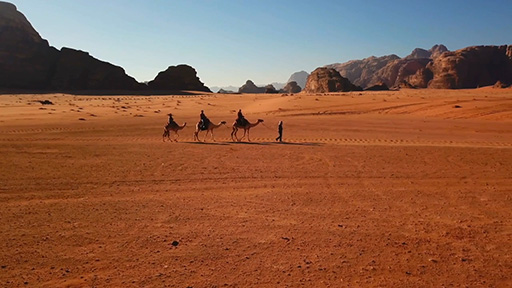1.6 Camels and humans as desert dwellers
Both humans and camels live in desert conditions and both rely on evaporative cooling to regulate their body temperatures. However, as this classic Open University video makes clear, the camel handles its water balance better than humans do, as well as having other adaptations that help it survive in a desert ecosystem.
Download this video clip.Video player: eco_1_openlearn_3_13_camels_and_humans_as_desert_dwellers.mp4


Transcript
Camels and humans as desert dwellers
[MUSIC PLAYING]
NARRATOR
The hot, dry conditions of the desert are inhospitable to most mammals because they cause overheating and dehydration. Yet, t8hese camels are desert dwellers, and compared to the men riding them, they're well-suited to a desert environment. The camels in this Jordanian desert patrol can travel up to 20 miles a day for 15 days without water. But their riders need to have regular stops for water and shade throughout the day.
[SINGING]
Such different abilities to cope with heat stress must lie in their physiological makeup. One built-in advantage for the camel is the extensive insulation provided by its fur coat. The fur acts as a heat barrier, helping to slow down the transfer of radiant and convective heat from the outside to the inside. To provide similar insulation, the men must wear suitable clothing. But they can't always compensate for being ill-adapted to this environment. Consider what problems in relation to temperature man faces in the desert heat. Also, what other adaptations, besides insulation, might the camel display? For instance, another advantage the camel has over man is revealed by a study of the fluctuations in body temperature throughout the day. The body temperature of a man rises to a critical level in only a few hours' exposure to desert heat. To lower this temperature, the man begins to sweat as a means of losing heat. The body temperature of the camel continues to rise past man's lethal limit, and the camel can sustain temperatures as high as 40 degrees centigrade without sweating. Not only does the camel have the ability to tolerate higher body temperatures than man, but its larger size allows it to store a larger amount of heat. The net effect is that it can postpone the onset of sweating, and in doing so, save a considerable amount of water. For the men to avoid losing too much water, their only alternative is to seek shade when it's available. By allowing its body temperature to rise by six degrees centigrade, the camel saves as much as four litres, or seven pints, of water. But if the heat load were maintained, then eventually the camel would have to sweat, and it, too, would become prone to dehydration. Dehydration is one of the major dangers facing mammals in the desert, and water holes are essential stops on a journey.
[WATER RUNNING]
As you might expect, desert-adapted animals tolerate dehydration very well, and can lose as much as 40% of their body weight without serious damage. But for man, the upper limit of tolerance is only 15% of his body weight before serious side effects are seen to interfere with blood circulation. Normally, the blood moves heat around the body, and exchanges heat to the outside of the skin surface. Dehydration causes rapid loss of water from the blood. The volume of the blood falls, it becomes more viscous, and the blood vessels contract. The result is that the heart has to work harder to pump the blood around the body. The effort becomes so great that the circulation becomes sluggish, and it's less efficient at moving heat to the skin's surface. As less heat is lost to the outside, the body temperature rises explosively. The camel, even under severe dehydration, loses water mainly from its stomach and large intestines, so the volume of the camel's blood changes very little, and is still able to transport and exchange heat efficiently. At the end of the day's journey, the camel's body temperature will be relatively high. As it's unloaded, the falling air temperatures of early evening give it the perfect opportunity to dump some of the heat it's stored during the day, and replenish itself with water. And where water is available, it can rapidly take it on board. A deficit of about 20% of its body weight can be made good within 10 minutes. In this time, the camel is able to drink something like 70 to 100 litres of water. That's equivalent to a man drinking 20 litres, or 30 pints.
[SPEAKING A FOREIGN LANGUAGE]
Air temperatures in the desert at night can fall very low. And whereas the men try to keep warm, the camel starts dumping its heat. Like a night storage radiator, it stores heat in the day, and gives it up at night so that by morning, it starts with a relatively low body temperature. So the secret of the camel's tolerance of desert conditions has nothing to do with its infamous hump, where fat is stored, not water. As we've seen, its success as a desert dweller relies upon physiological adaptations to heat stress and dehydration.
Interactive feature not available in single page view (see it in standard view).
